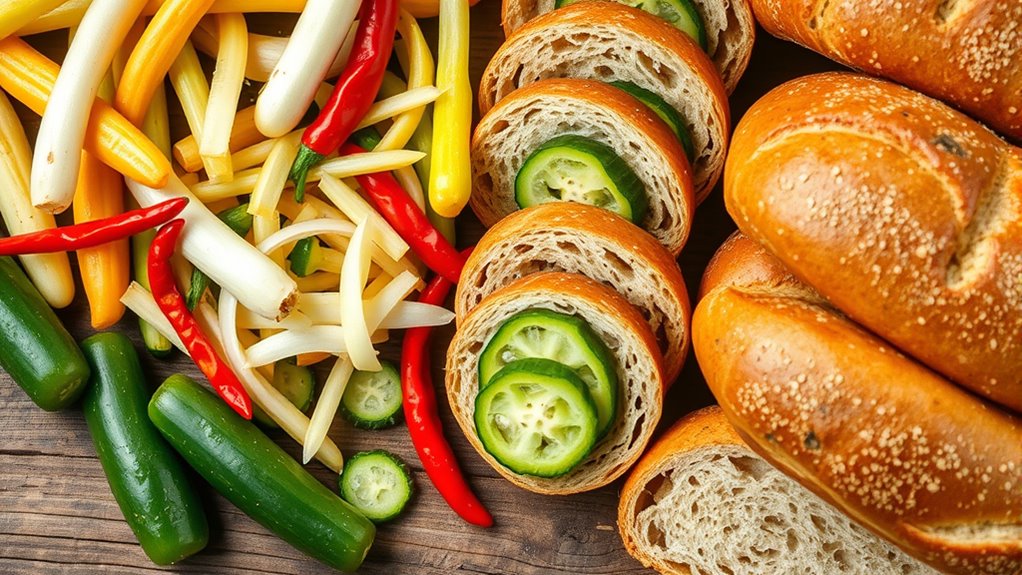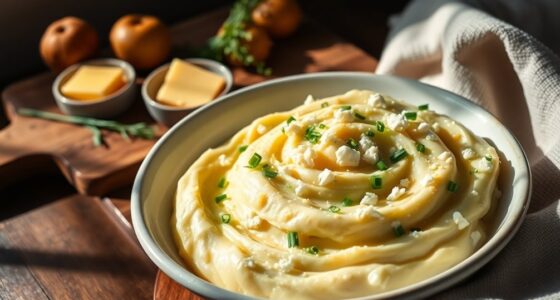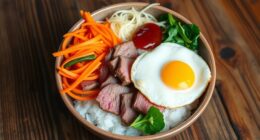To make an authentic bánh mì, choose a light, crisp baguette with a chewy interior, ideally warmed and fresh. Prepare vibrant pickled vegetables by thinly slicing carrots and daikon, then soaking them in a tangy, slightly sweet brine made with rice vinegar, sugar, and salt. For the perfect crunch, use firm vegetables and refrigerate for at least 24 hours. Add fresh herbs and flavorful spreads to complete your sandwich—keep going to discover additional tips for balanced flavor and texture.
Key Takeaways
- Choose a freshly baked, thin, chewy baguette with a crispy crust for authentic texture.
- Slice vegetables like carrots and daikon into matchstick sizes for proper pickling and crunch.
- Prepare a brine with rice vinegar, water, sugar, and salt, adjusting acidity and sweetness for balanced flavor.
- Briefly blanch vegetables in boiling water, then cool in ice to enhance crispness and preserve texture.
- Incorporate fresh herbs and spreads to complement the pickled vegetables and bread, balancing flavors.
Selecting the Perfect Baguette for Your Bánh Mì
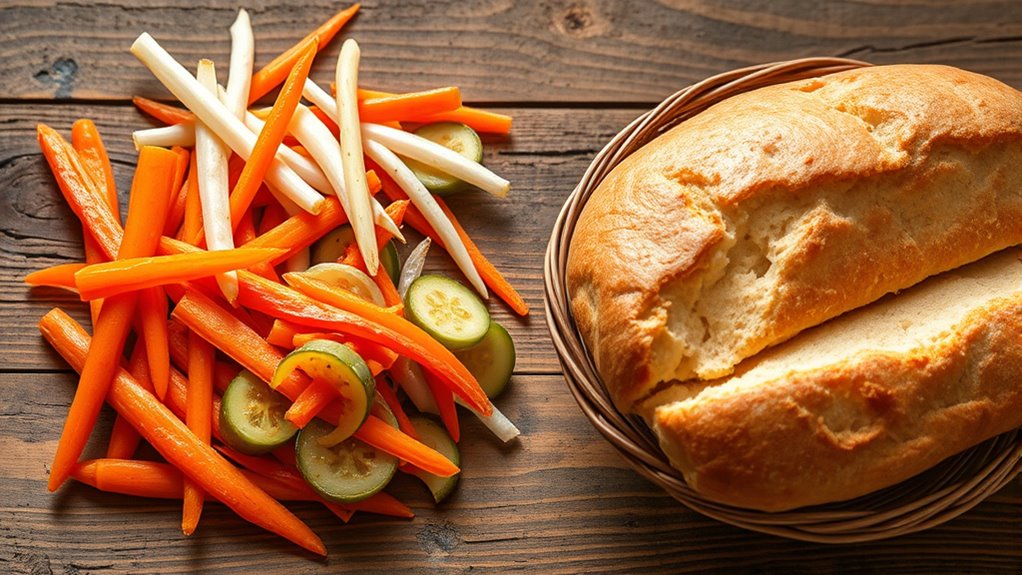
Have you ever wondered why the baguette is such a crucial element in an authentic Bánh Mì? It’s because the bread’s texture and crust play a huge role in the sandwich’s overall experience. You want a baguette that’s light, airy inside, with a crisp, golden crust on the outside. Look for one that’s freshly baked, preferably with a thin, chewy crust that won’t overpower the fillings. Avoid overly dense or soft bread, as it can make the sandwich feel heavy and soggy. The right baguette provides a sturdy base that holds the ingredients together without falling apart. When selecting your baguette, choose one that’s slightly warm and has a subtle, yeasty aroma. This ensures every bite delivers that perfect balance of crunch and tenderness. Additionally, a properly baked baguette with consistent crust and crumb enhances the overall texture and flavor of your Bánh Mì.
Preparing Authentic Pickled Vegetables
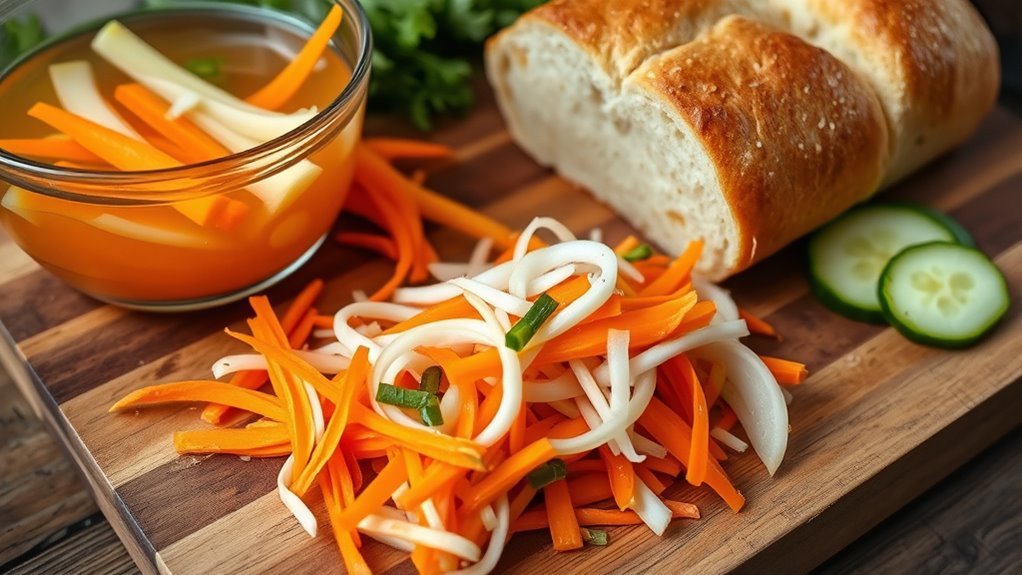
Preparing authentic pickled vegetables is essential for adding crunch and tang to your Bánh Mì. To do this, start by thinly slicing carrots and daikon radish into matchstick-sized pieces. In a jar, combine equal parts rice vinegar and water, then add sugar and salt to taste—stir until dissolved. You can also include a splash of fish sauce or chili for extra flavor. Submerge the vegetables in the brine, ensuring they’re fully covered. Let them sit at room temperature for about 30 minutes for a quick pickle or refrigerate for several hours for more developed flavor. The key is to use fresh vegetables and a balanced brine that complements your sandwich without overpowering it. Properly preparing your vegetables ensures the best flavor and texture for your sandwich, and proper storage can help maintain their crunch and freshness longer. Additionally, choosing appropriate raw ingredients can enhance the overall quality of your pickled vegetables, ensuring they remain crisp and flavorful over time. Maintaining the correct fermentation process is crucial for achieving optimal flavor and texture in your pickled vegetables. Using quality ingredients can also make a noticeable difference in the final taste and appearance of your pickles. These pickled vegetables will bring that signature crunch and tang to your Bánh Mì.
Balancing Flavors in Your Pickle Brine
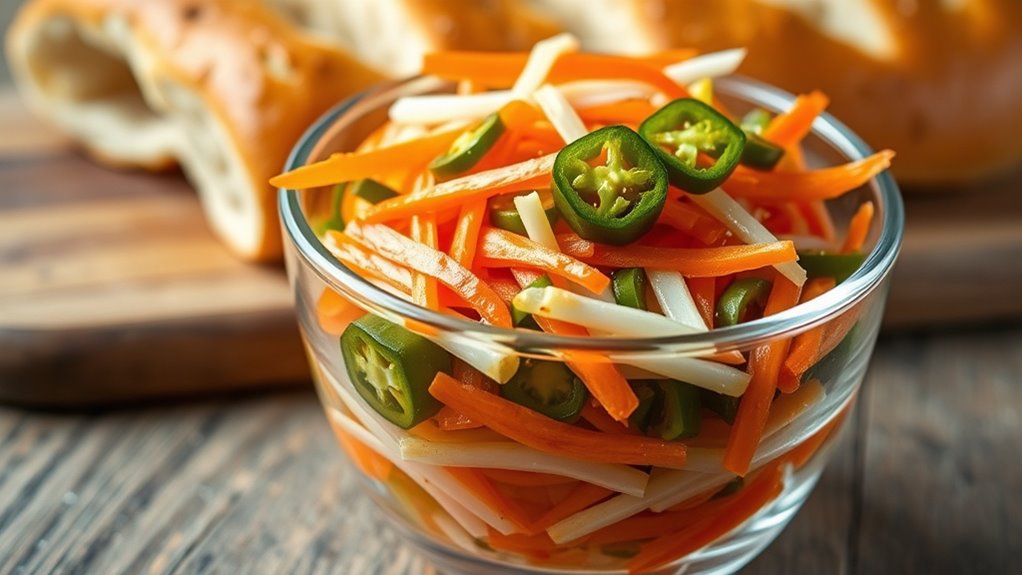
To achieve the perfect balance of flavors in your pickle brine, focus on harmonizing acidity, sweetness, saltiness, and umami. Start by adjusting the vinegar level to ensure a bright tang without overpowering the vegetables. Add a touch of sugar to counteract acidity and bring a subtle sweetness that complements the savory elements. Salt enhances the overall flavor and helps preserve freshness, so don’t skimp on it. Incorporate ingredients like fish sauce or soy sauce for umami depth, but use them sparingly to avoid overwhelming the other flavors. Taste your brine as you go, making small adjustments until it strikes a lively, well-rounded flavor profile. Remember, a balanced brine will elevate your pickled vegetables and improve your bánh mì experience.
Tips for Achieving the Ideal Crunch and Texture
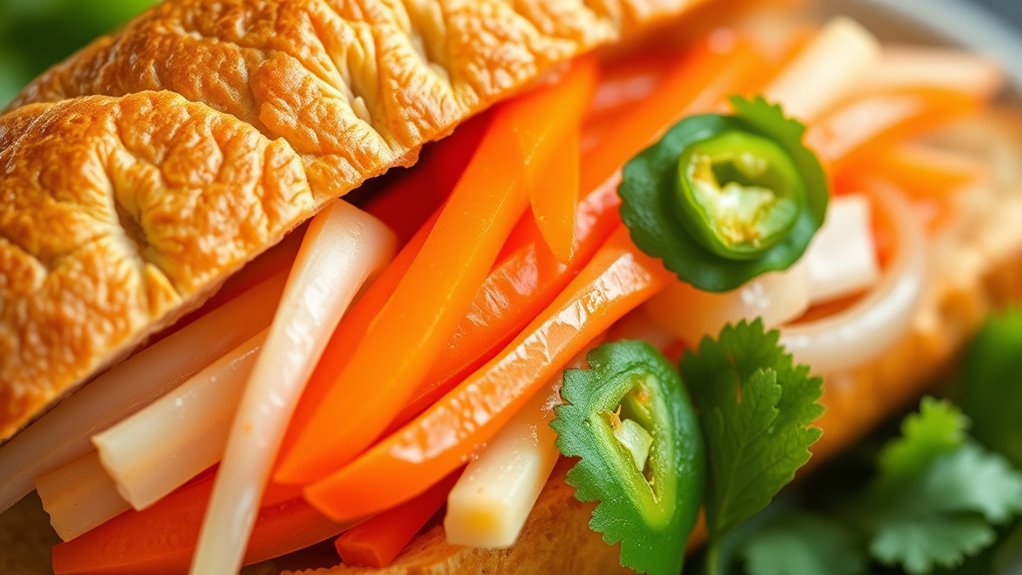
Achieving the perfect crunch in your bánh mì pickles starts with selecting the right vegetables and handling them properly. Use firm, fresh cucumbers, carrots, and daikon radishes, avoiding wilted or soft produce. Slice them uniformly to ensure even brining and crispness. When preparing, blanch the vegetables briefly in boiling water, then immediately shock them in ice water to maintain their firmness. Proper salting also helps draw out moisture, enhancing texture. Don’t overcrowd the jar—leave space for the brine to circulate freely. Use a balanced vinegar mixture to ensure the vegetables absorb flavor without becoming soggy. Incorporating proper handling techniques during preparation can further improve the texture and crunch of your pickles. Additionally, understanding Vetted – 1st Home Theatre Projector can help you choose appropriate storage conditions for your pickles, ensuring they stay crisp over time. Proper storage conditions are essential for maintaining texture and flavor during fermentation and preservation. For optimal results, consider temperature control when storing your pickles to preserve their crispness. Ultimately, refrigerate the pickles for at least 24 hours; patience allows the vegetables to develop that desirable, satisfying crunch you want in your bánh mì.
Incorporating Fresh Herbs and Spreads for Enhanced Flavor
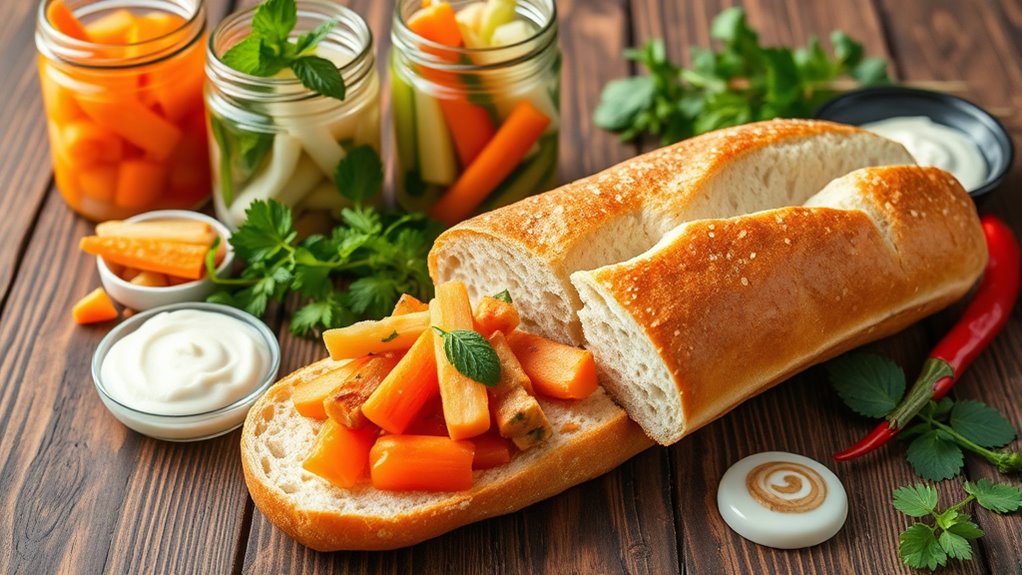
Adding fresh herbs and spreads elevates the flavor of your bánh mì, giving it a vibrant and aromatic profile. Choose herbs like cilantro, basil, and mint to add brightness and complexity. Layering these directly onto the bread enhances each bite’s freshness. Spreads, such as pâté or mayonnaise, provide a creamy texture that balances the crunchy vegetables and savory fillings. Spread a thin layer on the bread before adding other ingredients to guarantee even flavor distribution. You can also experiment with chili sauce or hoisin for a touch of sweetness and heat. Incorporating these elements transforms a simple sandwich into a flavorful, fragrant masterpiece. Remember, flavor balance is key—use herbs and spreads to complement, not overpower, the core ingredients of your bánh mì. Additionally, understanding leadership skills such as attention to detail and strategic thinking can help you perfect your culinary creations. Paying attention to culinary techniques, like proper layering and seasoning, can further enhance your bánh mì’s flavor profile. For example, utilizing herb pairing principles can help you create more harmonious flavor combinations.
Frequently Asked Questions
What Are the Origins of Traditional Vietnamese Bánh Mì?
You wonder about the origins of traditional Vietnamese bánh mì. You should know it combines French colonial influences with Vietnamese ingredients and flavors. The baguette, a French import, was adapted to local tastes, creating a unique bread. Meanwhile, pickled vegetables and savory fillings reflect Vietnamese culinary traditions. This fusion resulted from Vietnam’s colonial history, blending French techniques with indigenous ingredients to produce the beloved bánh mì you enjoy today.
How Long Can Homemade Pickled Vegetables Be Stored?
You can store homemade pickled vegetables for up to 2 to 3 weeks in the refrigerator. Keep them in a clean, airtight jar to maintain freshness and prevent spoilage. Make sure the vegetables stay submerged in the brine, as this helps preserve flavor and texture. Regularly check for any signs of spoilage, like bad odor or mold, and discard if you notice any issues.
Are There Vegan Options for Bánh Mì Fillings?
Your curiosity about vegan bánh mì fillings is as bright as a thousand suns. Yes, you can easily find delicious vegan options like tofu, seitan, or grilled vegetables, all packed with flavor and texture. Fresh herbs, spicy peppers, and vegan mayonnaise enhance the sandwich without animal products. So, whether you’re vegan or just exploring, you can enjoy a bánh mì that’s satisfying, vibrant, and totally cruelty-free.
What Are Common Mistakes to Avoid When Making Bánh Mì?
When making bánh mì, avoid overstuffing the sandwich, which can make it difficult to eat and cause ingredients to fall out. Don’t forget to balance flavors—too much sauce or spice can overpower the delicate balance. Use fresh, quality ingredients and make certain your bread is properly baked for the right texture. Also, steer clear of neglecting proper pickling techniques, as they add essential flavor and crunch to your bánh mì.
Can Gluten-Free Bread Be Used for Authentic Bánh Mì?
You can use gluten-free bread for bánh mì, but it won’t be truly authentic. Traditional bánh mì features airy, chewy baguette made with wheat flour, which contributes to its signature texture and flavor. If you choose gluten-free bread, expect a different experience; it might lack the same crust and chewiness. For the most authentic taste, stick to traditional baguette, but gluten-free options can still make a tasty sandwich.
Conclusion
Think of making bánh mì like tuning an instrument—you want every note just right. When you choose the perfect baguette, prepare tangy pickles, and add fresh herbs, you’re creating harmony in every bite. I once watched a friend craft her bánh mì, and each step brought her sandwich to life, like a symphony. With a little patience and attention, you’ll turn simple ingredients into a flavorful masterpiece that keeps everyone coming back for more.
